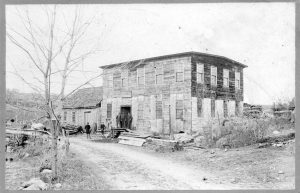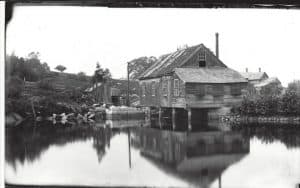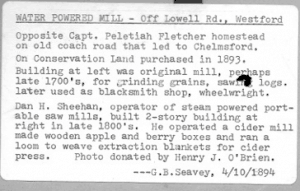
by Bob Oliphant and Marilyn Day


The Cider Mill Pond Conservation Land consists of three parcels (the Taylor, MacDougall and Agnew parcels) south of Lowell Road and west of Stony Brook Road around Cider Mill Pond totaling almost 39 acres. The land was acquired for conservation purposes in 1983 and 1984.
The Westford Conservation Trust has established trails that are entered off Lowell Road just west of the road’s bridge over Tadmuck Brook. The trails extend south from that point, bending both to the east where they lead to Stony Brook Road and Calista Terrace, and to the west. The trails pass by the so-called Indian Grinding Stone and the foundation of the old mill at Cider Mill Pond owned by Daniel H. Sheehan (1864-1944).
The pond was formed by damming Tadmuck Brook. The water from the mill pond was used to drive the mill’s machinery. In the early 20th century, when Daniel Sheehan ran the mill, he made, at various times, cider and vinegar, cotton, burlap and wool cloth. He also ran it as a sawmill.
Prior to that, the building had other uses, described in an article in the “Westford Wardsman” on May 29, 1909, written by Samuel Taylor whose family’s land would later become part of the Cider Mill Pond Conservation area.
He wrote: “This old building has been occupied for various industries by various parties: first by the owner of a carpenter shop, next by Waldron Bros. of Nelson, N.H., for a wheelwright shop, followed by James Barney of North Chelmsford, who continued the wheel industry. There being too much wheeling for the amount of water-wheel power to make wheels with, he departed on a wheel for elsewhere. For a few years Hamblett & Brown of Brookside and West Chelmsford opened it as a studio for painting, confined mostly to wagons, sleighs and wheelbarrows, then True A. Bean of Westford believed there was money to be made in wheels and he started in to demonstrate it, but didn’t make enough to – well never mind, guess at it. After a lapse of useful idleness for a season, Fisher & Fifield started in to make brackets, and continued to do so without any racket, until the firm was dissolved by an active law of nature with cemetery proceedings.” Excerpted from The Westford Gazetteer – A History of Westford In Its Place Names by Bob Oliphant, copyright 2010
In 2004 the Westford museum calendar featured the Sheehan Cider Mill for the month of November – the month when cider making is at its peak. Sitting on a dammed section of Tadmuck Brook, the mill was a center of commercial enterprise. Dan Sheehan made woven burlap cloth and cider here. Daniel had bought the property in 1887 from a Mr. Edgar H. Clapp, and after his death in late 1944, the estate of Daniel Sheehan sold the property to William R. Taylor in June of 1945. Most folks don’t realize that the old woods road here was once part of the Salem Road, also called “The Old Coach Road,” a road that farmers could use to transport their goods for trade down to the busy seaport of Salem, Mass. Likewise, goods for the hinterland were brought out over the road. Today, you can see the old stone walls that lined both sides of the Salem Road. If you follow the road east, it then crosses Stony Brook Road and goes in about where Calista Terrace is today; then it crosses the Hill apple orchards and comes out again on Chamberlin Road and continues on Hunt Road. Today there are still several old houses standing that were along that old Salem Road. But, back to Dan Sheehan. His advertisement for burlap described it as made of cotton and camel’s hair for press cloth for straining cider, wine and oil. Maybe his variety differed, and was less coarse, than the type used for grain bags. – An excerpt from an article by Marilyn Day, Sept. 2006
